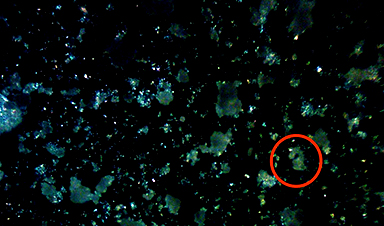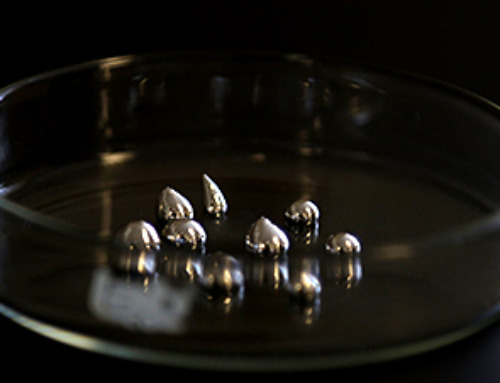| Multiple myeloma is an incurable bone marrow cancer that kills over 100,000 people every year. Known for its quick and deadly spread, this disease is one of the most challenging to address. As these cancer cells move through different parts of the body, they mutate, outpacing possible treatments. People diagnosed with severe multiple myeloma that is resistant to chemotherapy typically survive for only three to six months. Innovative therapies are desperately needed to prevent the spread of this disease and provide a fighting chance for those who suffer from it. | |
| Michael Mitchell, J. Peter and Geri Skirkanich Assistant Professor of Innovation in Bioengineering (BE), and Christian Figueroa-Espada, doctoral student in BE at the University of Pennsylvania School of Engineering and Applied Science, created an RNA nanoparticle therapy that makes it impossible for multiple myeloma to move and mutate. The treatment, described in their study published in PNAS (“In vivo bone marrow microenvironment siRNA delivery using lipid–polymer nanoparticles for multiple myeloma therapy”), turns off a cancer-attracting function in blood vessels, disabling the pathways through which multiple myeloma cells travel. |
| By shutting down this “chemical GPS” that induces the migration of cancer cells, the team’s therapy stops the spread of multiple myeloma, helping to eliminate it altogether. | |
| Endothelial cells, those that line blood vessels, produce a protein we need to survive. This protein, CyPA, is responsible for folding and transporting other proteins. It also activates T-cell responses when we get sick. | |
| However, when multiple myeloma is present, endothelial cells overexpress CyPA and secrete it into the blood vessels where its functions become malignant. Here, CyPA is a chemo-attractant, meaning it pulls multiple myeloma cells from the bone marrow into the blood vessels where they travel quickly to other bones in the body. | |
| “To stop the spread, we aimed to turn off this function of CyPA using RNA therapy, targeting the microenvironment of the cancer instead of the cancer cell itself,” says Mitchell. “But getting nucleic acids into the marrow was challenging due to the complex biological barriers.” | |
| To get the RNA into the hard-to-reach bone marrow, the team needed to redesign the traditional delivery vehicle for the lipid nanoparticle. | |
| “We designed a new hybrid nanoparticle that could deliver small interfering RNA (siRNA) to endothelial cells,” says Figueroa-Espada. “The siRNA stops cells from producing CyPA. When tested in vitro, the therapy prevented the spread of cancer cells. When tested in mice, both alone and in combination with chemotherapies, our therapy was able to decrease the size of tumors, extend survival rates and decrease the cancer’s resistance to chemotherapy.” | |
| “This work can help improve current treatments for multiple myeloma as well as other cancers that spread through the blood vessels,” adds Mitchell. “Using our platform for targeted nanoparticle development, we are looking forward to investigating other cancers and diseases where CyPA is overexpressed.” | |
| By creating a roadblock in cancer’s commute through the body, the Penn Engineering team is removing a longstanding barrier in the treatment of multiple myeloma, providing real hope for people diagnosed with this disease. | |
| In future work, the team plans to investigate silencing additional functions in the microenvironments of cancers to better overcome drug resistance, cancer initiation, and metastasis. They are currently working with Ruben Carrasco, Professor of Pathology at the Dana-Farber Cancer Institute and co-corresponding author of this study, to identify potential targets for this kind of therapy. Once RNA nanoparticle therapy is proven safe in larger animals, this proof-of-concept study can move forward to clinical trials. |
| Source: By Melissa Pappas, University of Pennsylvania (Note: Content may be edited for style and length) |
News
Measles Is Back: Doctors Warn of Dangerous Surge Across the U.S.
Parents are encouraged to contact their pediatrician if their child has been exposed to measles or is showing symptoms. Pediatric infectious disease experts are emphasizing the critical importance of measles vaccination, as the highly [...]
AI at the Speed of Light: How Silicon Photonics Are Reinventing Hardware
A cutting-edge AI acceleration platform powered by light rather than electricity could revolutionize how AI is trained and deployed. Using photonic integrated circuits made from advanced III-V semiconductors, researchers have developed a system that vastly [...]
A Grain of Brain, 523 Million Synapses, Most Complicated Neuroscience Experiment Ever Attempted
A team of over 150 scientists has achieved what once seemed impossible: a complete wiring and activity map of a tiny section of a mammalian brain. This feat, part of the MICrONS Project, rivals [...]
The Secret “Radar” Bacteria Use To Outsmart Their Enemies
A chemical radar allows bacteria to sense and eliminate predators. Investigating how microorganisms communicate deepens our understanding of the complex ecological interactions that shape our environment is an area of key focus for the [...]
Psychologists explore ethical issues associated with human-AI relationships
It's becoming increasingly commonplace for people to develop intimate, long-term relationships with artificial intelligence (AI) technologies. At their extreme, people have "married" their AI companions in non-legally binding ceremonies, and at least two people [...]
When You Lose Weight, Where Does It Actually Go?
Most health professionals lack a clear understanding of how body fat is lost, often subscribing to misconceptions like fat converting to energy or muscle. The truth is, fat is actually broken down into carbon [...]
How Everyday Plastics Quietly Turn Into DNA-Damaging Nanoparticles
The same unique structure that makes plastic so versatile also makes it susceptible to breaking down into harmful micro- and nanoscale particles. The world is saturated with trillions of microscopic and nanoscopic plastic particles, some smaller [...]
AI Outperforms Physicians in Real-World Urgent Care Decisions, Study Finds
The study, conducted at the virtual urgent care clinic Cedars-Sinai Connect in LA, compared recommendations given in about 500 visits of adult patients with relatively common symptoms – respiratory, urinary, eye, vaginal and dental. [...]
Challenging the Big Bang: A Multi-Singularity Origin for the Universe
In a study published in the journal Classical and Quantum Gravity, Dr. Richard Lieu, a physics professor at The University of Alabama in Huntsville (UAH), which is a part of The University of Alabama System, suggests that [...]
New drug restores vision by regenerating retinal nerves
Vision is one of the most crucial human senses, yet over 300 million people worldwide are at risk of vision loss due to various retinal diseases. While recent advancements in retinal disease treatments have [...]
Shingles vaccine cuts dementia risk by 20%, new study shows
A shingles shot may do more than prevent rash — it could help shield the aging brain from dementia, according to a landmark study using real-world data from the UK. A routine vaccine could [...]
AI Predicts Sudden Cardiac Arrest Days Before It Strikes
AI can now predict deadly heart arrhythmias up to two weeks in advance, potentially transforming cardiac care. Artificial intelligence could play a key role in preventing many cases of sudden cardiac death, according to [...]
NanoApps Medical is a Top 20 Feedspot Nanotech Blog
There is an ocean of Nanotechnology news published every day. Feedspot saves us a lot of time and we recommend it. We have been using it since 2018. Feedspot is a freemium online RSS [...]
This Startup Says It Can Clean Your Blood of Microplastics
This is a non-exhaustive list of places microplastics have been found: Mount Everest, the Mariana Trench, Antarctic snow, clouds, plankton, turtles, whales, cattle, birds, tap water, beer, salt, human placentas, semen, breast milk, feces, testicles, [...]
New Blood Test Detects Alzheimer’s and Tracks Its Progression With 92% Accuracy
The new test could help identify which patients are most likely to benefit from new Alzheimer’s drugs. A newly developed blood test for Alzheimer’s disease not only helps confirm the presence of the condition but also [...]
The CDC buried a measles forecast that stressed the need for vaccinations
This story was originally published on ProPublica, a nonprofit newsroom that investigates abuses of power. Sign up to receive our biggest stories as soon as they’re published. ProPublica — Leaders at the Centers for Disease Control and Prevention [...]





















